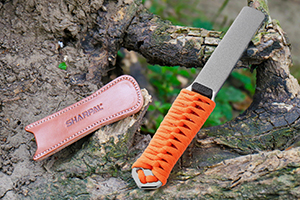
SHARPAL BUDDYGUARD sharpener is an advanced tool designed for both seasoned adventurers and casual campers. Its full tang stainless steel body is coated with monocrystalline diamonds, ensuring a durable and long-lasting sharpening surface. With a dual-grit design featuring a coarse 325 grit and an extra fine 1200 grit, this sharpener is capable of both reshaping a dull blade and refining it to a razor-sharp edge.
Preparation: No lubrication is required, which means you can sharpen your knives anywhere, anytime. Before you start, make sure your knife is clean and free of debris. Unsheath the sharpener and get ready to restore your blade.
Edge Setting with Coarse Grit: For knives that have become dull or have small nicks in the blade, begin with the coarse side.
Angle Guide: The built-in 20-degree angle guide ensures that you maintain the proper angle for most outdoor knives. Position the blade against the guide to maintain consistency throughout the sharpening process.
Sharpening Strokes: Using moderate pressure, push the blade along the length of the sharpener, from the base to the tip, as if you are trying to slice off a thin layer from the sharpener. Repeat this motion several times on one side before switching to the other, maintaining the same number of strokes for symmetry.
Honing with Extra Fine Grit: After setting the initial edge:
Switch Sides: Flip over to the 1200 grit side for honing. This fine grit smooths out the blade’s edge and polishes it, enhancing sharpness.
Refining the Edge: Using lighter pressure than before, repeat the sharpening strokes. The finer grit removes any remaining burrs and perfects the blade’s edge.
Stropping for a Polished Finish: To achieve a professionally sharpened edge:
Use the leather sheath that doubles as a strop. Lay it on a stable surface and gently pull the blade across the strop, edge trailing (opposite to sharpening), to align the micro-edge and polish it.
Survival Tasks with Paracord: Your sharpening tool is equipped with 6.6 feet of paracord, useful for a myriad of survival tasks like securing gear, repairing equipment, or emergency first aid applications.
SHARPAL BUDDYGUARD Dual-Grit Diamond Sharpener with Leather Strop is not only a sharpening tool but also a survival tool. It’s compact, easy to use, and requires no additional materials like oil, making it an excellent choice for keeping your knives sharp while on the go. Regular use will keep your knives in peak condition, making your outdoor experiences safer and more enjoyable.




